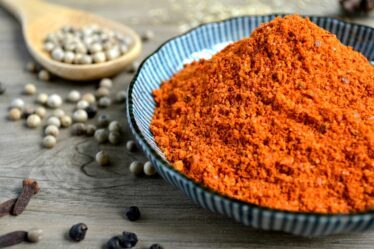
Chili powder is a staple in many kitchens around the world. Its vibrant red color and fiery flavor add a burst of excitement to any dish. From spicy chili con carne to zesty salsa, chili powder is a versatile ingredient that can elevate the taste of any meal. In this article, we will delve into the world of chili powder, exploring its different types, health benefits, and creative uses. Get ready for a spicy adventure!
Key Takeaways
- Chili powder comes in different types, including ancho, cayenne, and chipotle.
- Adding chili powder to your meals can provide health benefits such as boosting metabolism and reducing inflammation.
- When choosing chili powder, consider the heat level, flavor profile, and intended use.
- Chili powder can be used in creative ways, such as in desserts and cocktails.
- Chili powder has a rich history and origin in Mexico and has been used for centuries.
- Some top brands of chili powder to try include McCormick, Badia, and Simply Organic.
- The spiciness of chili powder comes from capsaicin, which stimulates pain receptors in the mouth.
- To keep chili powder fresh and flavorful, store it in an airtight container in a cool, dark place.
- Homemade chili powder recipes can be customized to your taste preferences and can elevate your cooking game.
- Pairing chili powder with other spices and herbs, such as cumin and oregano, can enhance the flavor of your dishes.
Understanding the Different Types of Chili Powders
When it comes to chili powder, there are various types available, each with its own unique flavor profile and heat level. The most common types include ancho chili powder, chipotle chili powder, and cayenne pepper. Ancho chili powder is made from dried poblano peppers and has a mild heat with a slightly sweet and smoky flavor. Chipotle chili powder, on the other hand, is made from smoked jalapeno peppers and has a medium heat with a rich and smoky flavor. Cayenne pepper is made from ground dried cayenne peppers and is known for its intense heat.
The confusion surrounding chili powder vs. chili pepper vs. cayenne pepper is understandable. Chili powder is a blend of spices that often includes ground chili peppers, along with other ingredients such as cumin, garlic powder, and oregano. On the other hand, chili pepper refers specifically to the dried fruit of the Capsicum plant, which can be ground into chili powder or used whole in cooking. Cayenne pepper is a specific type of chili pepper that is known for its spiciness.
The Health Benefits of Adding Chili Powder to Your Meals
In addition to adding flavor to your meals, chili powder also offers several health benefits. One of the key benefits is its anti-inflammatory properties. Chili powder contains capsaicin, which has been shown to reduce inflammation in the body. This can be particularly beneficial for individuals with conditions such as arthritis or inflammatory bowel disease.
Another potential health benefit of chili powder is its ability to aid in weight loss. Capsaicin has been found to increase metabolism and promote fat burning. Additionally, chili powder can help to curb appetite and reduce cravings, making it a useful tool for those looking to shed a few pounds.
It is important to note, however, that moderation is key when consuming spicy foods. While chili powder can offer health benefits, consuming excessive amounts can lead to digestive issues such as heartburn or stomach ulcers. It is always best to listen to your body and consume chili powder in moderation.
How to Choose the Best Chili Powder for Your Cooking Needs
| Factors to Consider | Importance | Options |
|---|---|---|
| Heat Level | High | Mild, Medium, Hot, Extra Hot |
| Flavor Profile | High | Smoky, Earthy, Fruity, Tangy |
| Color | Medium | Red, Brown, Orange, Yellow |
| Origin | Low | Mexico, India, Thailand, China |
| Price | Low | Budget, Mid-Range, Premium |
When selecting chili powder for your cooking needs, there are a few factors to consider. First and foremost, you’ll want to determine the level of heat you desire. If you prefer milder flavors, opt for ancho chili powder. For a medium heat, chipotle chili powder is a great choice. And if you’re a fan of intense spiciness, cayenne pepper will be your go-to.
In addition to heat level, it is important to consider the quality and freshness of the chili powder. Look for brands that use high-quality ingredients and avoid additives or fillers. Freshness is also key, as older chili powder may lose its flavor and potency over time. If possible, purchase whole dried chili peppers and grind them yourself for the freshest flavor.
Creative Ways to Incorporate Chili Powder into Your Everyday Meals
Chili powder is not just limited to savory dishes like chili con carne or tacos. It can also be used in unexpected ways to add a kick of flavor to sweet dishes and beverages. For example, try adding a pinch of chili powder to your hot chocolate for a spicy twist on a classic treat. You can also sprinkle some chili powder on fresh fruit, such as mango or watermelon, for a unique and refreshing snack.
In terms of savory dishes, chili powder can be used in a variety of cuisines. Add it to marinades for grilled meats, sprinkle it on roasted vegetables, or mix it into salad dressings for an extra burst of flavor. The possibilities are endless!
The History and Origin of Chili Powder

Chili powder has a rich history that dates back centuries. It is believed to have originated in Mexico, where chili peppers have been cultivated for thousands of years. The Aztecs and Mayans were known to use chili peppers in their cooking, and they even believed that the spicy fruit had medicinal properties.
The use of chili powder spread throughout the world thanks to explorers and traders. It made its way to Europe in the 15th century and quickly became popular in Spain and Portugal. From there, it traveled to other parts of Europe and eventually reached Asia, where it became a staple in Indian and Thai cuisine.
The Top Brands of Chili Powder to Try Today
When it comes to choosing a brand of chili powder, there are several options available. Some popular brands include McCormick, Badia, and Simply Organic. These brands offer high-quality chili powder that is free from additives and fillers.
When selecting a brand, it is important to read the ingredient label to ensure that you are getting pure chili powder without any added spices or preservatives. Additionally, consider purchasing smaller quantities of chili powder to ensure freshness and potency.
The Science Behind the Spiciness of Chili Powder
The spiciness of chili powder is due to a chemical compound called capsaicin. Capsaicin is found in the white pithy membrane inside chili peppers, which is where most of the heat is concentrated. When capsaicin comes into contact with the taste buds on your tongue, it triggers a burning sensation.
The heat of chili powder is measured using the Scoville scale, which assigns a numerical value to the spiciness of chili peppers and chili powders. For example, bell peppers have a Scoville rating of zero, while cayenne pepper can range from 30,000 to 50,000 Scoville heat units (SHU). The higher the SHU, the spicier the chili powder.
How to Store Chili Powder to Keep it Fresh and Flavorful
To keep your chili powder fresh and flavorful, it is important to store it properly. The key is to keep it away from heat and moisture, as these can cause the spices to lose their potency and flavor.
Store your chili powder in an airtight container in a cool, dark place, such as a pantry or cupboard. Avoid storing it near the stove or other sources of heat, as this can cause the spices to degrade more quickly. Additionally, be sure to tightly seal the container after each use to prevent moisture from getting in.
Homemade Chili Powder Recipes to Elevate Your Cooking Game
If you’re feeling adventurous, why not try making your own chili powder at home? Not only will you have control over the ingredients and heat level, but you’ll also be able to enjoy the freshest flavor possible.
To make your own chili powder, start by selecting your preferred chili peppers. You can choose from ancho peppers, chipotle peppers, or cayenne peppers, depending on your desired level of heat. Remove the stems and seeds from the peppers and toast them in a dry skillet over medium heat until they become fragrant. Allow them to cool before grinding them into a fine powder using a spice grinder or mortar and pestle.
Pairing Chili Powder with Other Spices and Herbs for Delicious Results
Chili powder pairs well with a variety of other spices and herbs, allowing you to create complex and flavorful dishes. Some popular combinations include chili powder with cumin, garlic powder, and oregano for a classic Mexican flavor profile. You can also experiment with adding cinnamon, cocoa powder, or nutmeg to chili powder for a unique twist.
When using multiple spices and herbs, it is important to balance the flavors to ensure that one does not overpower the others. Start with small amounts of each spice and taste as you go, adjusting the quantities as needed. Remember, cooking is all about experimentation and finding what works best for your taste buds.
Chili powder is a versatile ingredient that can add a burst of flavor and heat to any dish. Whether you’re a fan of mild flavors or crave intense spiciness, there is a chili powder out there for you. From its health benefits to its creative uses, chili powder has something to offer everyone.
So go ahead, embrace the heat and experiment with chili powder in your own cooking. Whether you’re making a classic chili con carne or adding a pinch to your morning eggs, chili powder is sure to spice up your meals and take your taste buds on a tantalizing journey.
Looking for the best chili powders to spice up your dishes? Look no further! We’ve got you covered with our top picks. And if you’re interested in exploring other unique flavors, check out this article on Flavorful Sips about the exotic fruit adventure of feijoa. It’s a fascinating read that will introduce you to a whole new world of flavors. So why not add some excitement to your culinary journey and give it a try? Click here to read more about it.



